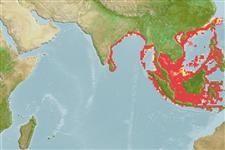|
Sepiida |
Sepiidae
Environment: milieu / climate zone / depth range / distribution range
Sinh thái học
; Mức độ sâu 10 - 100 m (Ref. 1695), usually 30 - 40 m (Ref. 346). Tropical; 27°N - 10°S, 79°E - 125°E (Ref. 1695)
Indo-West Pacific: Southern India to Andaman Sea, Gulf of Tonkin, Java, Sulu and Celebes seas.
Length at first maturity / Bộ gần gũi / Khối lượng (Trọng lượng) / Age
Maturity: Lm ? range ? - ? cm Max length : 11.0 cm ML con đực/không giới tính; (Ref. 1695)
Common length: 4.0 to 7.0 cm (Ref. 275). Common mantle ranges between 4 and 7 cm (Ref. 3722). Usually caught using otter trawl, some using pair trawl, small catches using squid light-lures, traps and push nets. Bottom otter and pair trawls are used offshore while push nets and lift nets are used in coastal waters and inshore (Ref. 346). Occurs at shallow coastal waters down to depths of 30 m (Ref. 275).
Life cycle and mating behavior
Chín muồi sinh dục | Sự tái sinh sản | Đẻ trứng | Các trứng | Sự sinh sản | Ấu trùng
Members of the class Cephalopoda are gonochoric. Male and female adults usually die shortly after spawning and brooding, respectively. Mating behavior: Males perform various displays to attract potential females for copulation. During copulation, male grasp the female and inserts the hectocotylus into the female's mantle cavity where fertilization usually occurs. Life cycle: Embryos hatch into planktonic stage and live for some time before they grow larger and take up a benthic existence as adults.
Roper, C.F.E., M.J. Sweeney and C.E. Nauen. 1984. (Ref. 275)
IUCN Red List Status (Ref. 130435)
CITES status (Ref. 108899)
Not Evaluated
Not Evaluated
Threat to humans
Human uses
| FishSource |
Các công cụ
Các nguồn internet
Estimates based on models
Preferred temperature
(Ref.
115969): 24.1 - 28.8, mean 28.1 (based on 164 cells).
Vulnerability
Low vulnerability (10 of 100).
